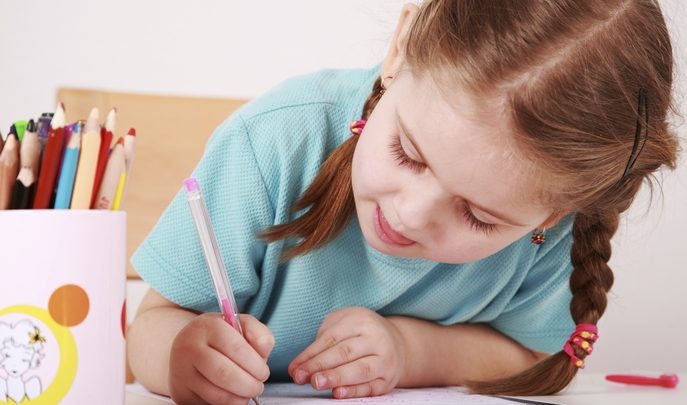“If you can grab children’s imaginations, you can get them writing without realising it”

We can’t force children to pick up their pens and expect fantastic learning to emerge – success comes from making writing irresistible, says Kirstine Beeley…

- by Kirstine Beeley
- Early years training consultant with 20 years of experience Visit website

Picture the scene – a classroom full of engaged children, actively exploring the world around them, making the most of every ounce of natural curiosity and imagination… when suddenly they are asked to stop and come together, leaving all that they are enjoying behind, to ‘do some writing’.
Little wonder then that these children subsequently choose not to write. To really engage children with writing in the early years, we have to rethink our approach.
In our increasingly technological world, what do we actually use writing for ? As adults we need to look for relevant opportunities and make sure we include them in our settings. Children need chances to write lists, letters, cards, labels, notes, post-its, crosswords, forms and so forth as part of their ongoing play.
The tools for mark making and early writing need to be in all areas, be they in pots, boxes, baskets or bags. The more we provide the means, the more chance we have of children writing when they have the motive.
As for story writing – how can children possibly write before they have built their own set of imaginative storytelling skills? What children write directly reflects what’s in their heads. If we don’t let them explore and build stories without going anywhere near a pencil, then there will be nothing to actually put on paper later (when they want to write!).
Something to write about
The writing process isn’t just about putting a pencil on a paper and making a mark; it’s about giving children a future means of expressing themselves, of getting their ideas onto paper and sharing their views. As such, a lot of the process of being an author doesn’t involve writing a word – it requires us to look at where, when and why things happen, how characters interact with each other, and develop stories from beginning to end.
In early years this is exactly what children are doing as they dig for treasure in the sand with their friends, or develop a recipe in the mud kitchen. As Peppa Pig plays with Spider-Man, an adventure is unfolding, while the rules for parking a vehicle in the tiny garage need to be discussed and shared.
Helping children to develop imagination, storytelling confidence and verbal narrative in their play means that when they are physically ready and inspired enough to pick up chalk, pencil or crayon, there will be a flow of exciting ideas coming out of the tip!
Inspire to engage
If you can find ways to grab children’s imagination, you can get them writing without realising it. The key is making writing an exciting prospect in all play, both indoors and out. Adults should be there to model writing, showing a shared love of print, rather than trying to squeeze out words on lines where no passion exists. Writing needs to be seen by practitioners and children alike as a fun activity, rather than a task to be completed with no relevance to their play world.
For example, small world play can be enhanced with signs or notes, while taking orders for soup in the mud kitchen gives a reason for writing. Taking pictures of these writing examples provides an elegant snapshot of children’s ongoing writing development rather than a forced assessment. But practitioners need to be really aware of the process of writing development and be celebrating all things written – not just words on lines with finger spaces.
Lead by example
As well as being physically ready, children need to see the purpose of print. They need to see things that they too can write, so a print-rich environment is essential. But I don’t mean a traditional ‘print-rich’ classroom where every basket, bucket and box is labelled with pictures and print – make sure your role play area is rich in logos, labels and signs from packets and tins, and that your reading area features magazines, newspapers and comics. Create labels featuring children’s names and display them around the setting (separate to their pictures for safeguarding reasons). Children’s early writing usually moves from marks to left-to-right patterns to including familiar letters from their environment and often from their own names, so the more they are able to see text and their own names, the more familiar they will be with the shapes, and the more confident they will be when trying to write (note – copying names over and over does not make a confident happy writer!).
Just make sure that signs and labels are wherever possible in adult hand-written text rather than computer printed – after all, what’s the point in asking children to write if they never see that we write too?
Celebrate the process
Finally, as with every author, young writers like to have an audience, so writing needs to be publicly celebrated with peers in exactly the same way we celebrate creativity and artwork. Try developing a writing wall where examples of lists, labels and other forms of early writing are given pride of place for all to see. This is also great for showing parents that writing is an evolving process. Be sure to include lots of photos of writing in all areas to promote writing throughout the setting.
Don’t forget – children need to be physically ready for writing before anything will emerge from the end of a crayon or pencil. Try holding a pencil between your toes and you will get a sense of how hard it is for young children before their muscles and brain coordination are developed sufficiently.
Alongside any early writing provocations, settings therefore need to be providing lots of opportunities to strengthen little fingers, arms and shoulders – all of which are key to the writing process.
Write here
Providing plenty of writing surfaces and pens, and making them freely accessible, will ensure that children have a chance to write without any pressure associated with getting it ‘right or wrong’…
• Tape large rolls of paper onto the floor, cover tabletops or paint a table with blackboard paint to create writing surfaces where children are used to playing comfortably. Sticking paper under tables offers an exciting twist (plus a chance to build shoulder and arm muscle control).
• Tape pens to toys cars for writing whilst driving to grab the imaginations of little car lovers.
• Wrap boxes in white paper or leave huge cardboard boxes with large marker pens to inspire children to pick up and go.
• Lay a large whiteboard on the floor with markers or write on a window with dry wipe markers to give children a chance to play at doing ‘grown-up’ writing or drawing.
• Cover crisp tubes with wrapping paper and fill them with pens, pencils and paper to excite children with a particular interest; gift boxes or bags packed with exciting writing tools and empty books and envelopes work well too.
Kirstine Beeley is an author and educational consultant; for more information, visit www.playingtolearnuk.com










